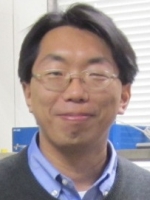Faculty
Hirofumi Yoshikawa
Major research activity
 Rechargeable battery, Capacitor, Nanocarbon
Rechargeable battery, Capacitor, Nanocarbon
Recently, much attention has been focused on the creation of new energy systems, such as high-performance rechargeable batteries, as a solution to the global energy and environmental crises. Redox active molecular materials are good candidates for a high-performance cathode active material. To achieve both rapid charge/discharge and high power density, we have developed “molecular cluster batteries” using polynuclear metal complex clusters (molecular clusters), which exhibit multi-electron redox reactions, as a cathode active material for lithium batteries, and then achieved a larger capacity than that of the present Li ion battery using LiCoO2as a cathode active material. Furthermore, to modify their battery performances, we also tried to nano-hybridize molecular clusters with nano-carbons such as single-walled carbon nanotubes, graphenes, and mesoporous carbons. The obtained nano-hybrid materials between molecular clusters and nano-carbons exhibited much larger capacities, compared with those of non-nanohybrid materials, due to the coexistence of redox reactions of molecular clusters and electrical double layer capacitors of nanocarbons enhanced by nanohybridization. These results indicated that development of redox active molecular materials and nanohybridization with nanocarbons are very important toward realization of next generation energy storage devices. From both viewpoints of applications and fundamental sciences, we are trying to investigate new materials and discover novel principles now.
Major relevant publications
- Zhang, Z., Yoshikawa, H., and Awaga, K. Monitoring the Solid-state Electrochemistry of Cu(2,7-AQDC) (AQDC=anthraquinone dicarboxylate) in a Lithium Battery: Coexistence of Metal and Ligand Redox Activities in a Metal-Organic Framework. J. Am. Chem. Soc., 136, 16112-16115 (2014)
- Shin, J.-Y., Yamada, T., Yoshikawa, H., Awaga, K., and Shinokubo, H. An Antiaromatic Electrode-Active Material Enabling High Capacity and Stable Performance of Rechargeable Batteries. Angew. Chem. Int. Ed., 53, 3096-3101 (2014)
- Kume, K., Kawasaki, N., Wang, H., Yamada, T., Yoshikawa, H., and Awaga, K. Enhanced capacitor effects in polyoxometalate/graphene nanohybrid materials; a synergetic approach to high performance energy storages. J. Mater. Chem. A, 2, 3801-3807 (2014)
- Yamada, T., Morita, K., Kume, K., Yoshikawa, H. and Awaga, K. The solid-state electrochemical reduction process of magnetite in Li batteries: in-situ magnetic measurements toward electrochemical magnets. J. Mater. Chem. C, 2, 5183-5188 (2014)
- Wang, H., Yamada, T., Hamanaka, S., Yoshikawa, H. and Awaga, K. Cathode Composition Dependence of the Battery Performance of Polyoxometalate (POM)-Molecular Cluster Batteries. Chem. Lett., 43, 1067-1069 (2014)



